BigFoot Networks Killer NIC: Killer Marketing or Killer Product?
by Gary Key on October 31, 2006 2:00 AM EST- Posted in
- Networking
Gaming Performance
As usual, gaming performance was tested with a variety of current games. We ran benchmarks at our standard 1280x1024 resolution. Given the number of users that run 19 inch LCDs these days, 1280x1024 represents one of the most commonly used resolutions at this time.
Battlefield 2
This benchmark is probably the most intense one we ran as it occurred on the Daqing Oilfield map with 64 players battling it out in a chaotic frenzy. This was also the most difficult map we had to experience from a viewpoint of keeping our players together and trying to accomplish the same tasks. If you saw two players constantly missing the vehicle rides and spending a lot of time in the trees sniping then it was us. We ran Battlefield 2 using the highest quality graphics settings available in the video settings. The game itself is best experienced with average in-game frame rates of 40 and up.
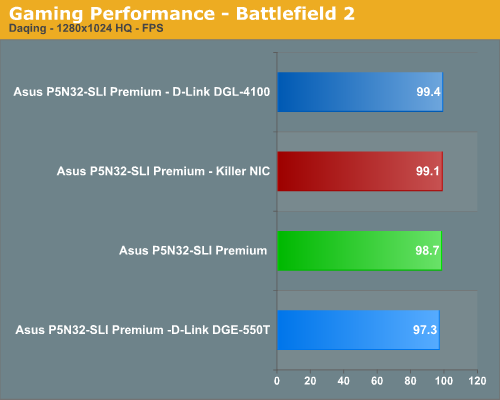

In our first game we actually find our D-Link combination performing slightly better than the other solutions from a benchmark viewpoint. During actual game play we noticed the frame rates and general smoothness of the system was best on the NVIDIA nForce 590SLI and followed closely by the Killer NIC. Several times during our testing with the D-Link DGL-4100 we would see several pauses while vehicles passed or several characters were in close proximity of each other. This behavior was worse on the D-Link DGE-550T when GameFuel was disabled on the router. In our first game we do not see $279.99 worth of game play improvement and the Killer NIC certainly did not allow us to dominate.
F.E.A.R.
We played both the Asylum and Deadwood 16-player maps. We decided to report the Asylum results as this is our favorite map currently. The Deadwood map generated similar results so we are not hiding any information. F.E.A.R. is a very graphics intensive game and we switch all graphic settings to maximum (except for soft shadows, which are disabled). An average frame rate for F.E.A.R. can dip into the teens at times which is not good for a first person shooter. We still found the game playable around 35fps or above in multiplayer.
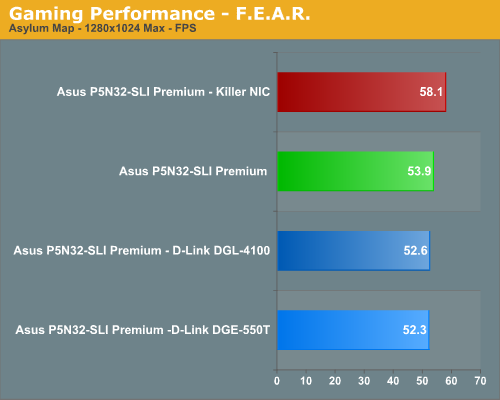

This is the money title for the Killer NIC. BigFoot Networks ships a copy of F.E.A.R. with every card so it should be expected to offer better frame rates and ping rates. We see a 7% increase in frame rates over the NVIDIA nForce 590SLI NIC and a 10% increase over the D-Link combination. In actual game play we found the Killer NIC to offer the most fluid experience and our ability to quickly transverse the map actually felt smoother than the other two solutions. The ping rates were actually higher than the D-Link router and nForce 590SLI but we did not find ping rate making a huge difference in this game. The question is did the Killer NIC improve our game play or skills? It really did not but it could for those who are significantly better players at this game than we are currently. In this case we will chalk a point up for the Killer NIC for improving frame rates.
Quake 4
This game should be a significant test for the Killer NIC as it requires extremely good hand to eye coordination along with lightning fast reflexes. This is just the game that would truly benefit from both improved ping and frame rates. We played on the Campgrounds Redux map with a total of 16 players. This is our favorite map from Quake III Arena and we were glad to see it return. We set our video settings to high and then fired up the game.
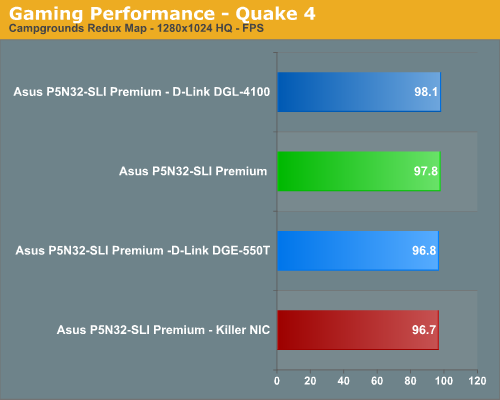
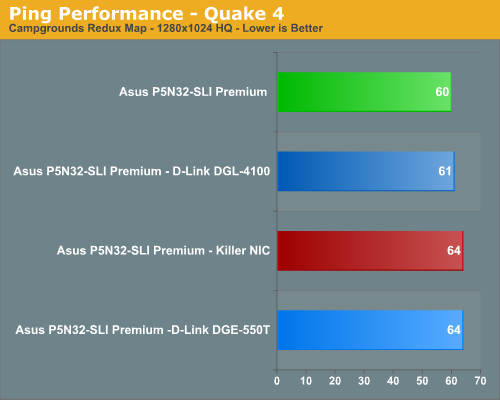
Actually, Quake 4 limits true frame rate to 60 fps during game play whether or not VSync is enabled. However, various timedemos and FRAPS will report the frame rate your system is capable of providing without the cap. In this case, we believe due to the speed of the game that ping rate is an extremely important performance measurement. This is one game where the Killer NIC loses on both fronts and it is mainly attributable to the excellent network code already provided in the game engine that does not benefit from offloading technology. The current performance leads us to believe we can expect to see the same results in the eagerly awaited Enemy Territory: Quake Wars.
Counter Strike Source
This is another game that BigFoot Networks touts as a premier title that will show improvements in both frame and ping rates. We are playing on the Office map with 32 players and we varied our online session times to ensure we were playing on a full server. Our settings were once again set to high quality at a 1280x1024 resolution. We find the game is very playable at 50 fps or better.
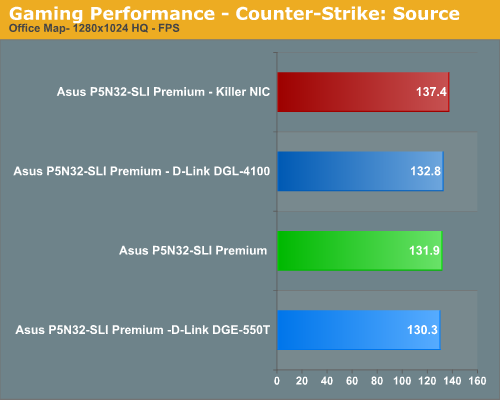

We did see frame rate improvements between three to five percent in this game. However, at these frame rates we really do not think a difference of 5% is going to matter much. Like Quake 4, an excellent ping rate in this game will make a difference and in this case we just did not see a large enough variation to make a difference in our experience. The Killer NIC did provide a positive experience to some degree in CSS as game play seemed to be a little smoother after firing your weapon than our other solutions. It was not a fire, frame hitch, and then move event we experienced a few other times during testing, especially with the D-Link PCI NIC. The Killer NIC gets a point for improving frame rates as advertised. We have to take it away for failing to improve our ping rates in a game where UltimatePing (reducing ping rates on the host system) could make a difference in actual game play.
Call of Duty 2
This is another popular shooter where frame rate and ping rate are very important especially in close quarters fighting. We played on the Caen map with a 24 player limit. The amount of packet processing this game generates is significantly higher at times than Counter Strike: Source so we expected our Killer NIC to shine in this area. Our video resolution is set to 1280x1024 with all options but AA enabled. We find the game is generally playable with a 40 fps or higher rate in multiplayer.
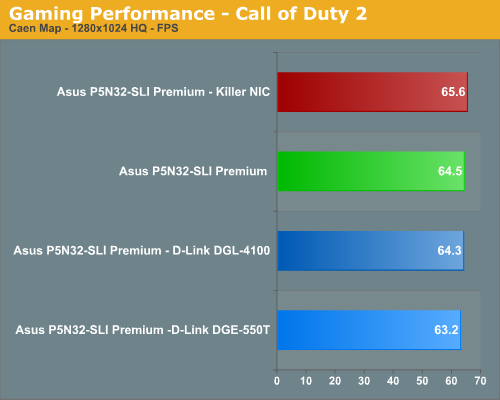
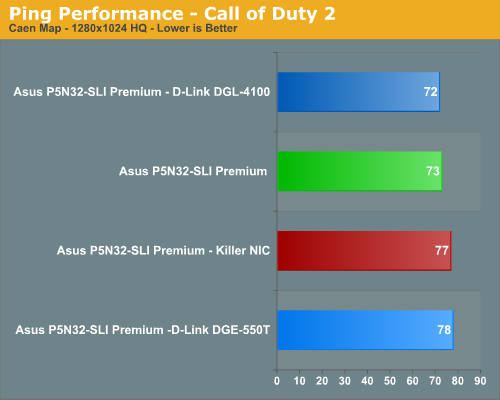
These results surprised us as we see minor frame rate improvements but ping rates were up to 7% greater than our D-Link router or NVIDIA NIC. The frame rate improvement is only worth mentioning because this game is generally GPU bound so any benchmark differences between systems is noticeable. Were the frame rate differences during game play noticeable? No they were not but we can tell you the increased ping rates were noticeable. This was the first game we encountered where the actual game play was not smooth with the Killer NIC. We noticed choppy break points at certain sections, especially when going building to building in the center of the map. We tried this map at different times during the day and noticed this issue several times. It seemed to be worse when throwing a grenade as we blew our selves up twice during testing. We might be slow and have weak arms in real life but our game characters did not need this handicap.
As usual, gaming performance was tested with a variety of current games. We ran benchmarks at our standard 1280x1024 resolution. Given the number of users that run 19 inch LCDs these days, 1280x1024 represents one of the most commonly used resolutions at this time.
Battlefield 2
This benchmark is probably the most intense one we ran as it occurred on the Daqing Oilfield map with 64 players battling it out in a chaotic frenzy. This was also the most difficult map we had to experience from a viewpoint of keeping our players together and trying to accomplish the same tasks. If you saw two players constantly missing the vehicle rides and spending a lot of time in the trees sniping then it was us. We ran Battlefield 2 using the highest quality graphics settings available in the video settings. The game itself is best experienced with average in-game frame rates of 40 and up.


In our first game we actually find our D-Link combination performing slightly better than the other solutions from a benchmark viewpoint. During actual game play we noticed the frame rates and general smoothness of the system was best on the NVIDIA nForce 590SLI and followed closely by the Killer NIC. Several times during our testing with the D-Link DGL-4100 we would see several pauses while vehicles passed or several characters were in close proximity of each other. This behavior was worse on the D-Link DGE-550T when GameFuel was disabled on the router. In our first game we do not see $279.99 worth of game play improvement and the Killer NIC certainly did not allow us to dominate.
F.E.A.R.
We played both the Asylum and Deadwood 16-player maps. We decided to report the Asylum results as this is our favorite map currently. The Deadwood map generated similar results so we are not hiding any information. F.E.A.R. is a very graphics intensive game and we switch all graphic settings to maximum (except for soft shadows, which are disabled). An average frame rate for F.E.A.R. can dip into the teens at times which is not good for a first person shooter. We still found the game playable around 35fps or above in multiplayer.


This is the money title for the Killer NIC. BigFoot Networks ships a copy of F.E.A.R. with every card so it should be expected to offer better frame rates and ping rates. We see a 7% increase in frame rates over the NVIDIA nForce 590SLI NIC and a 10% increase over the D-Link combination. In actual game play we found the Killer NIC to offer the most fluid experience and our ability to quickly transverse the map actually felt smoother than the other two solutions. The ping rates were actually higher than the D-Link router and nForce 590SLI but we did not find ping rate making a huge difference in this game. The question is did the Killer NIC improve our game play or skills? It really did not but it could for those who are significantly better players at this game than we are currently. In this case we will chalk a point up for the Killer NIC for improving frame rates.
Quake 4
This game should be a significant test for the Killer NIC as it requires extremely good hand to eye coordination along with lightning fast reflexes. This is just the game that would truly benefit from both improved ping and frame rates. We played on the Campgrounds Redux map with a total of 16 players. This is our favorite map from Quake III Arena and we were glad to see it return. We set our video settings to high and then fired up the game.


Actually, Quake 4 limits true frame rate to 60 fps during game play whether or not VSync is enabled. However, various timedemos and FRAPS will report the frame rate your system is capable of providing without the cap. In this case, we believe due to the speed of the game that ping rate is an extremely important performance measurement. This is one game where the Killer NIC loses on both fronts and it is mainly attributable to the excellent network code already provided in the game engine that does not benefit from offloading technology. The current performance leads us to believe we can expect to see the same results in the eagerly awaited Enemy Territory: Quake Wars.
Counter Strike Source
This is another game that BigFoot Networks touts as a premier title that will show improvements in both frame and ping rates. We are playing on the Office map with 32 players and we varied our online session times to ensure we were playing on a full server. Our settings were once again set to high quality at a 1280x1024 resolution. We find the game is very playable at 50 fps or better.


We did see frame rate improvements between three to five percent in this game. However, at these frame rates we really do not think a difference of 5% is going to matter much. Like Quake 4, an excellent ping rate in this game will make a difference and in this case we just did not see a large enough variation to make a difference in our experience. The Killer NIC did provide a positive experience to some degree in CSS as game play seemed to be a little smoother after firing your weapon than our other solutions. It was not a fire, frame hitch, and then move event we experienced a few other times during testing, especially with the D-Link PCI NIC. The Killer NIC gets a point for improving frame rates as advertised. We have to take it away for failing to improve our ping rates in a game where UltimatePing (reducing ping rates on the host system) could make a difference in actual game play.
Call of Duty 2
This is another popular shooter where frame rate and ping rate are very important especially in close quarters fighting. We played on the Caen map with a 24 player limit. The amount of packet processing this game generates is significantly higher at times than Counter Strike: Source so we expected our Killer NIC to shine in this area. Our video resolution is set to 1280x1024 with all options but AA enabled. We find the game is generally playable with a 40 fps or higher rate in multiplayer.


These results surprised us as we see minor frame rate improvements but ping rates were up to 7% greater than our D-Link router or NVIDIA NIC. The frame rate improvement is only worth mentioning because this game is generally GPU bound so any benchmark differences between systems is noticeable. Were the frame rate differences during game play noticeable? No they were not but we can tell you the increased ping rates were noticeable. This was the first game we encountered where the actual game play was not smooth with the Killer NIC. We noticed choppy break points at certain sections, especially when going building to building in the center of the map. We tried this map at different times during the day and noticed this issue several times. It seemed to be worse when throwing a grenade as we blew our selves up twice during testing. We might be slow and have weak arms in real life but our game characters did not need this handicap.










87 Comments
View All Comments
WileCoyote - Friday, November 3, 2006 - link
I said it's too wordy. That means take out words. Are you people for real?Frumious1 - Tuesday, October 31, 2006 - link
That post was too short. Three sentences with no real support to back it up. Lamest comment ever.Look, sorry you have poor reading skillz, but a lot of us are quite educated and like to know the WHY and HOW besides just the WHAT. My first thought was "how in the hell is this product supposed to do ANYTHING for frame rates!?" Gary answered that by looking into the details more than superficially. Oh, sure, it doesn't really deliver -- a 5% increase on a moderately high-end system is pretty silly for a $270 product -- but that it can affect frame rates at all is surprising to me. I now have hope for Windows Vista, at least on the networking stack side of things.
What's really odd is that the review is pretty clearly advising people to NOT go out and buy this "killer" product, because it just isn't that great. If I saw a review on AnandTech that bashed a product without any backing material, I'd feel I was reading something at HardOCP. Well, okay, they back up their complaints sometimes, but their testing methodology is worse than suspect. Remember the Core 2 "launch" reviews where they used a midrange GPU config to conclude that it did nothing for gaming performance?
Anyway, there seem to be quite a few new names on here for this article. Wonder how many are employed by BigFoot? It's like there are a bunch of people bashing Gary for even reviewing the product at all, another group that's bashing him for not liking the card, a third group bashing him for not being able to do a 1 page writeup, and then a few people that think: "nice review; didn't surprise me much with the results, but at least we can now know that Killer can help in certain situations, even if it's overpriced as hell."
I'm sure Gary was tested a lot more than is shown in this article. I've conversed with him in the past, and I'd wager he was pulling his hair out over this article. How many times did you write it Gary? Ten? More? I think you ought to post here and set the record straight, because my bet is that in terms of improving gaming performance the Killer NIC is as good as a NIC is going to get... which means the other NICs from Intel, 3COM, etc. are basically all as good as onboard solutions if that. There's really not much you can do to truly improve performance of a NIC for online gaming when you're looking at maybe 5ms worst case being delay added by the hardware and OS.
As I said above in an earlier comment, it would be nice to have more developers like Jon Carmac around, because he apparently knows how to already perform well without lots of extra hardware. Can't say his games are the greatest, but the Doom 3 engine and networking aspects (client/server architecture) are clearly ahead of most other FPS solutions.
WileCoyote - Wednesday, November 1, 2006 - link
I was trying to keep my comment short, simple, and to the point. I don't need to write a page defending my opinion on something as trivial as a product review. The numbers speak for themselves in this review. And it wasn't so much the quantity but rather the quality - there is little to no structure in the review. That's fact, not opinion. There is a better way to write a review - I've read hundreds of them on Anandtech.I guess my Bachelor's Degree in Anthropology from a well-respected U.S. university doesn't count for much and neither does the successful business I created/own which pays a six-figure salary.
Gary Key - Wednesday, November 1, 2006 - link
Apparently my MBA and the fact I am already retired (at 44 and doing this because I really enjoy it) does not count for very much either. LOL.....
Seriously, I am always looking to improve. How would you change the structure of the article?
Aikouka - Tuesday, October 31, 2006 - link
Being that I run an FTP server that tends to see a decent amount of internal traffic, it actually sounds like a TNIC (or simply making a dedicated server) could actually be beneficial to me. Although, I sure have no desire to pay $300 for that card when I could easily spend the money on a second video card for SLi purposes or such. Also, I know switching from single to dual-core really helped to off-set the issue of FTP uploading on the local intranet. It really won't matter as when I build a new PC next month, I'm simple setting my old PC as a dedicated server to offload those annoying tasks.Also, Mlau, there are some games where "real estate" matters. World of Warcraft is a great example of this and I'm glad that I play the game in 1650x1080, because in certain situations, there's so much junk on your screen (I may call it junk but it actually helps :P), that you need all the extra room you can get. You may be happy in 1024x768, but that gives you no right to vehemently demean people for wanting to play in higher resolutions, which doing so also provides a better quality picture without wasting resources on Anti-Aliasing. Almost all the time, enjoying a game the way the developers designed/envisioned it can be an enriching experience for the gamer.
Gary, your comment about WoW being limited to 64 FPS... I think you may've left Vertical Sync on :D. I can easily get 90FPS on my dated Athlon 64 X2 4400+ with a GeForce 6800GT OC playing in 1650x1080 with max graphics settings. Albeit, I don't get a constant 90FPS, but it can be easily attainable in non-expansive places. So yeah, if your refresh rate on your LCD/CRT was set to 60Hz, you probably would see your game hover around 60-64FPS or somwhere between that and 30FPS. I know I turned VSync off on mine as I couldn't constantly achieve 60FPS, so the game lowered my FPS to about 30 with VSync turned on. Simply turning it off raised me to an easy 45 minimum with no tearing evident. I know that in the Hillsbrad/Alterac area, I would probably get around 45-60 depending on how far into the distance I could see.
Gary Key - Wednesday, November 1, 2006 - link
http://forums.worldofwarcraft.com/thread.html;jses...">Blizzard ResponseHi,
We tried your suggestions during testing and nothing helped. We used both LCD and CRT monitors with vsync off. This was with several different video cards and Core 2 Duo/AM2 X2 processors. The frame rates were always capped to 64 until we switched to a single core processor on either system. We contacted Blizzard directly and they confirmed the dual core bug. The link above has their response on line item 6. Are you using FRAPS to capture the frame rates? If so which version please?
Thanks!!!
goinginstyle - Thursday, November 2, 2006 - link
I downloaded FRAPS 2.81 and sure enough my 4800+ X2 is capped at 64FPS.otherwise - Tuesday, October 31, 2006 - link
You can get an 10/100 ethernet card with a TOE dirt cheap for much less then $300 if you really want one. With most people who actuially need a TOE also demanding 10/100/1000 support, there is a glut of 10/100 TOE NICs.dijuremo - Tuesday, October 31, 2006 - link
You will probably get more out of $300 if you get a hardware raid controller for your system (Areca comes to mind) which will not only provide a speed upin storage, but also redundancy for your system. I know it does nothing for your network performance, but is money better spent which is my point.I considered getting a Killer NIC for my new system, but did not do it because of price, no PCI-Express support (Mobo only has 2 PCI slots used for sound card and HDTV tuner and has 4 PCI Express slots, one used currently for Nvidia 7950GX2), plus performance gains were not that good (I read another review of this card about a month ago elsewhere).
As for the person saying sli/xfire is useless, you are totally wrong. At 1920x1080 (using the LVM-37w3 LCD monitor - 1080p native) you need sli or xfire to have decent speeds to play games with AA and AF. If you don't play games or play at 1280x1024 or less it does not matter, but above that you really need sli or xfire.
I also agree the article was a bit too long and actually more effective that a Lunesta overdose. Not sure if the writer is trying to avoid what just happened to HEXUS where they reviewed an Alienware PC and got e-mail back from the company saying they would not get any more harware because of the bad review...
heated snail - Tuesday, October 31, 2006 - link
I don't mean to be a jerk, and I appreciate any sincere and fact-finding test/review article. However:I'm amazed, was this really a review of a basic hardware item? Because instead it reads like a mini-novel about all the difficulty the testers/reviewers had in doing their job. Is it too much to ask for a more verbally efficient writing style? About two paragraphs briefly acknowledging that this product has been hyped in the media, and acknowledging that testing was a little more difficult than usual... then get straight to the tests on page two and conclusions on page three. I can't believe how long it took to read through this whole thing with its very repetitive descriptions and self-references.